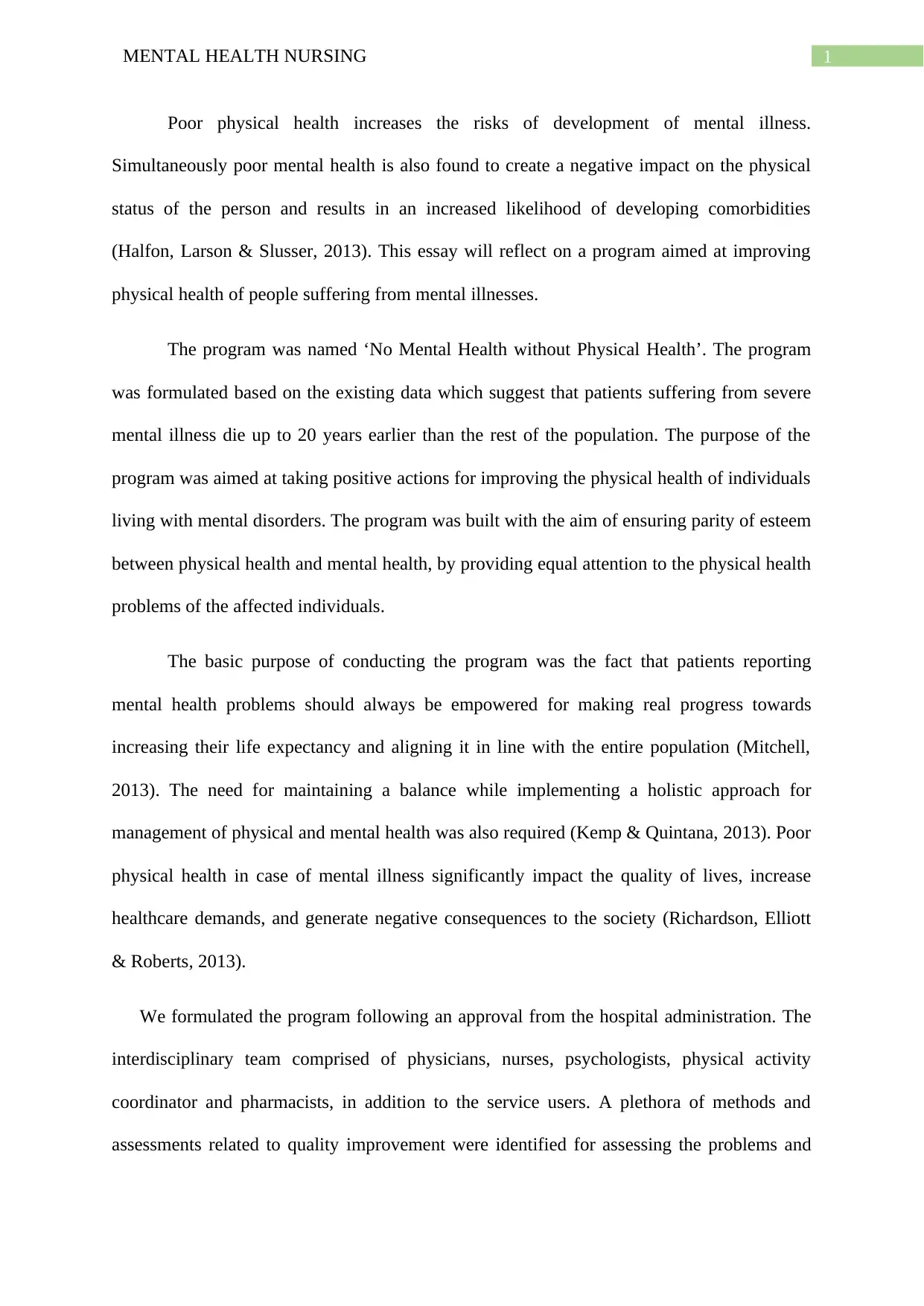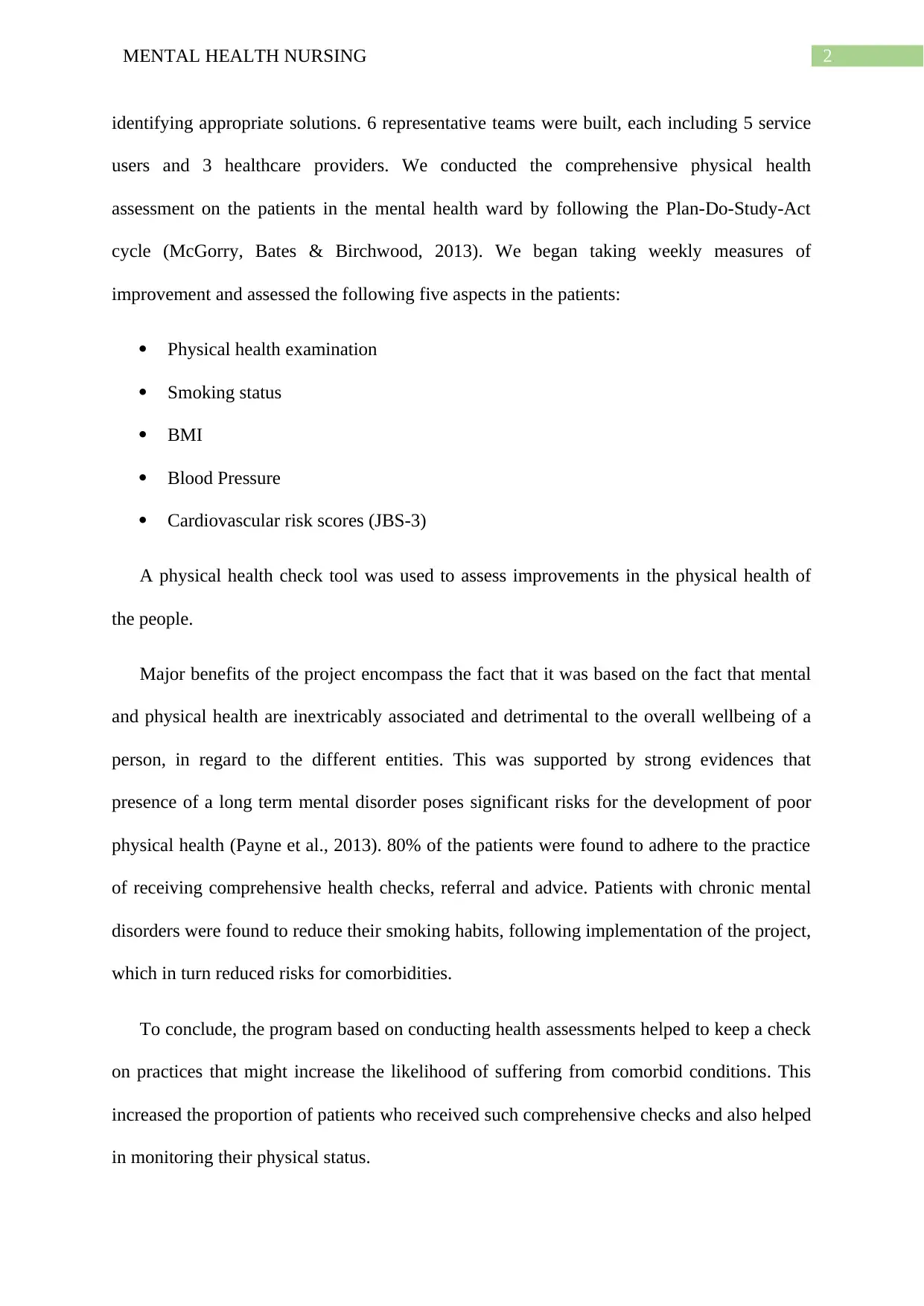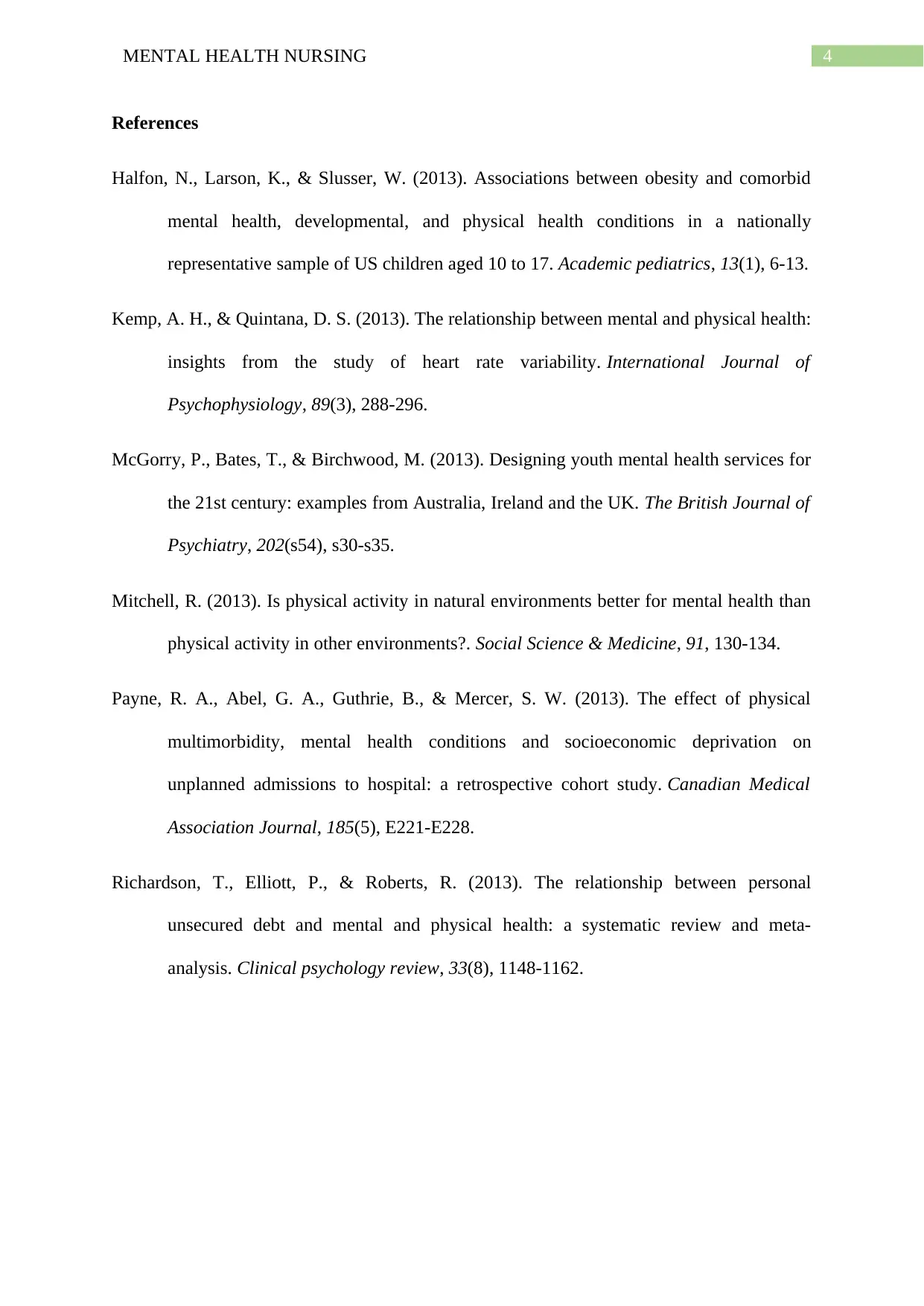Critical Reflection: Mental Health Nursing and Physical Well-being
VerifiedAdded on 2023/06/10
|5
|920
|377
Essay
AI Summary
This essay provides a critical reflection on the 'No Mental Health without Physical Health' program, which aimed to improve the physical well-being of individuals with mental disorders. The program was developed in response to data indicating significantly shorter lifespans for those with severe mental illness. An interdisciplinary team, including physicians, nurses, psychologists, and service users, implemented comprehensive physical health assessments using the Plan-Do-Study-Act cycle, focusing on aspects like physical examination, smoking status, BMI, blood pressure, and cardiovascular risk scores. The project highlighted the inextricable link between mental and physical health, demonstrating that addressing physical health concerns can reduce the risk of comorbidities and improve overall patient outcomes, with 80% of patients adhering to health checks, referral, and advice.

Running head: MENTAL HEALTH NURSING
Critical reflection
Name of the Student
Name of the University
Author Note
Critical reflection
Name of the Student
Name of the University
Author Note
Paraphrase This Document
Need a fresh take? Get an instant paraphrase of this document with our AI Paraphraser

1MENTAL HEALTH NURSING
Poor physical health increases the risks of development of mental illness.
Simultaneously poor mental health is also found to create a negative impact on the physical
status of the person and results in an increased likelihood of developing comorbidities
(Halfon, Larson & Slusser, 2013). This essay will reflect on a program aimed at improving
physical health of people suffering from mental illnesses.
The program was named ‘No Mental Health without Physical Health’. The program
was formulated based on the existing data which suggest that patients suffering from severe
mental illness die up to 20 years earlier than the rest of the population. The purpose of the
program was aimed at taking positive actions for improving the physical health of individuals
living with mental disorders. The program was built with the aim of ensuring parity of esteem
between physical health and mental health, by providing equal attention to the physical health
problems of the affected individuals.
The basic purpose of conducting the program was the fact that patients reporting
mental health problems should always be empowered for making real progress towards
increasing their life expectancy and aligning it in line with the entire population (Mitchell,
2013). The need for maintaining a balance while implementing a holistic approach for
management of physical and mental health was also required (Kemp & Quintana, 2013). Poor
physical health in case of mental illness significantly impact the quality of lives, increase
healthcare demands, and generate negative consequences to the society (Richardson, Elliott
& Roberts, 2013).
We formulated the program following an approval from the hospital administration. The
interdisciplinary team comprised of physicians, nurses, psychologists, physical activity
coordinator and pharmacists, in addition to the service users. A plethora of methods and
assessments related to quality improvement were identified for assessing the problems and
Poor physical health increases the risks of development of mental illness.
Simultaneously poor mental health is also found to create a negative impact on the physical
status of the person and results in an increased likelihood of developing comorbidities
(Halfon, Larson & Slusser, 2013). This essay will reflect on a program aimed at improving
physical health of people suffering from mental illnesses.
The program was named ‘No Mental Health without Physical Health’. The program
was formulated based on the existing data which suggest that patients suffering from severe
mental illness die up to 20 years earlier than the rest of the population. The purpose of the
program was aimed at taking positive actions for improving the physical health of individuals
living with mental disorders. The program was built with the aim of ensuring parity of esteem
between physical health and mental health, by providing equal attention to the physical health
problems of the affected individuals.
The basic purpose of conducting the program was the fact that patients reporting
mental health problems should always be empowered for making real progress towards
increasing their life expectancy and aligning it in line with the entire population (Mitchell,
2013). The need for maintaining a balance while implementing a holistic approach for
management of physical and mental health was also required (Kemp & Quintana, 2013). Poor
physical health in case of mental illness significantly impact the quality of lives, increase
healthcare demands, and generate negative consequences to the society (Richardson, Elliott
& Roberts, 2013).
We formulated the program following an approval from the hospital administration. The
interdisciplinary team comprised of physicians, nurses, psychologists, physical activity
coordinator and pharmacists, in addition to the service users. A plethora of methods and
assessments related to quality improvement were identified for assessing the problems and

2MENTAL HEALTH NURSING
identifying appropriate solutions. 6 representative teams were built, each including 5 service
users and 3 healthcare providers. We conducted the comprehensive physical health
assessment on the patients in the mental health ward by following the Plan-Do-Study-Act
cycle (McGorry, Bates & Birchwood, 2013). We began taking weekly measures of
improvement and assessed the following five aspects in the patients:
Physical health examination
Smoking status
BMI
Blood Pressure
Cardiovascular risk scores (JBS-3)
A physical health check tool was used to assess improvements in the physical health of
the people.
Major benefits of the project encompass the fact that it was based on the fact that mental
and physical health are inextricably associated and detrimental to the overall wellbeing of a
person, in regard to the different entities. This was supported by strong evidences that
presence of a long term mental disorder poses significant risks for the development of poor
physical health (Payne et al., 2013). 80% of the patients were found to adhere to the practice
of receiving comprehensive health checks, referral and advice. Patients with chronic mental
disorders were found to reduce their smoking habits, following implementation of the project,
which in turn reduced risks for comorbidities.
To conclude, the program based on conducting health assessments helped to keep a check
on practices that might increase the likelihood of suffering from comorbid conditions. This
increased the proportion of patients who received such comprehensive checks and also helped
in monitoring their physical status.
identifying appropriate solutions. 6 representative teams were built, each including 5 service
users and 3 healthcare providers. We conducted the comprehensive physical health
assessment on the patients in the mental health ward by following the Plan-Do-Study-Act
cycle (McGorry, Bates & Birchwood, 2013). We began taking weekly measures of
improvement and assessed the following five aspects in the patients:
Physical health examination
Smoking status
BMI
Blood Pressure
Cardiovascular risk scores (JBS-3)
A physical health check tool was used to assess improvements in the physical health of
the people.
Major benefits of the project encompass the fact that it was based on the fact that mental
and physical health are inextricably associated and detrimental to the overall wellbeing of a
person, in regard to the different entities. This was supported by strong evidences that
presence of a long term mental disorder poses significant risks for the development of poor
physical health (Payne et al., 2013). 80% of the patients were found to adhere to the practice
of receiving comprehensive health checks, referral and advice. Patients with chronic mental
disorders were found to reduce their smoking habits, following implementation of the project,
which in turn reduced risks for comorbidities.
To conclude, the program based on conducting health assessments helped to keep a check
on practices that might increase the likelihood of suffering from comorbid conditions. This
increased the proportion of patients who received such comprehensive checks and also helped
in monitoring their physical status.
⊘ This is a preview!⊘
Do you want full access?
Subscribe today to unlock all pages.

Trusted by 1+ million students worldwide

3MENTAL HEALTH NURSING
Paraphrase This Document
Need a fresh take? Get an instant paraphrase of this document with our AI Paraphraser

4MENTAL HEALTH NURSING
References
Halfon, N., Larson, K., & Slusser, W. (2013). Associations between obesity and comorbid
mental health, developmental, and physical health conditions in a nationally
representative sample of US children aged 10 to 17. Academic pediatrics, 13(1), 6-13.
Kemp, A. H., & Quintana, D. S. (2013). The relationship between mental and physical health:
insights from the study of heart rate variability. International Journal of
Psychophysiology, 89(3), 288-296.
McGorry, P., Bates, T., & Birchwood, M. (2013). Designing youth mental health services for
the 21st century: examples from Australia, Ireland and the UK. The British Journal of
Psychiatry, 202(s54), s30-s35.
Mitchell, R. (2013). Is physical activity in natural environments better for mental health than
physical activity in other environments?. Social Science & Medicine, 91, 130-134.
Payne, R. A., Abel, G. A., Guthrie, B., & Mercer, S. W. (2013). The effect of physical
multimorbidity, mental health conditions and socioeconomic deprivation on
unplanned admissions to hospital: a retrospective cohort study. Canadian Medical
Association Journal, 185(5), E221-E228.
Richardson, T., Elliott, P., & Roberts, R. (2013). The relationship between personal
unsecured debt and mental and physical health: a systematic review and meta-
analysis. Clinical psychology review, 33(8), 1148-1162.
References
Halfon, N., Larson, K., & Slusser, W. (2013). Associations between obesity and comorbid
mental health, developmental, and physical health conditions in a nationally
representative sample of US children aged 10 to 17. Academic pediatrics, 13(1), 6-13.
Kemp, A. H., & Quintana, D. S. (2013). The relationship between mental and physical health:
insights from the study of heart rate variability. International Journal of
Psychophysiology, 89(3), 288-296.
McGorry, P., Bates, T., & Birchwood, M. (2013). Designing youth mental health services for
the 21st century: examples from Australia, Ireland and the UK. The British Journal of
Psychiatry, 202(s54), s30-s35.
Mitchell, R. (2013). Is physical activity in natural environments better for mental health than
physical activity in other environments?. Social Science & Medicine, 91, 130-134.
Payne, R. A., Abel, G. A., Guthrie, B., & Mercer, S. W. (2013). The effect of physical
multimorbidity, mental health conditions and socioeconomic deprivation on
unplanned admissions to hospital: a retrospective cohort study. Canadian Medical
Association Journal, 185(5), E221-E228.
Richardson, T., Elliott, P., & Roberts, R. (2013). The relationship between personal
unsecured debt and mental and physical health: a systematic review and meta-
analysis. Clinical psychology review, 33(8), 1148-1162.
1 out of 5
Related Documents
Your All-in-One AI-Powered Toolkit for Academic Success.
+13062052269
info@desklib.com
Available 24*7 on WhatsApp / Email
![[object Object]](/_next/static/media/star-bottom.7253800d.svg)
Unlock your academic potential
Copyright © 2020–2025 A2Z Services. All Rights Reserved. Developed and managed by ZUCOL.





